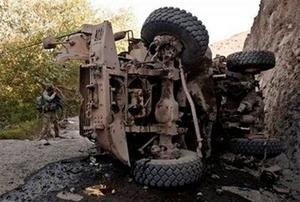IED detectionOld fashioned methods best for detecting IEDs
U.S. troops in Afghanistan and Iraq have resorted to an old method to detect improvised explosive devices (IEDs); using long poles with hooks on the end, troops feel around in the dirt to detect any IEDs

IED attack site in Warduk province, Afghanistan // Source: uruknet.info
U.S. troops in Afghanistan and Iraq have resorted to an old method to detect improvised explosive devices (IEDs).Using long poles with hooks on the end, troops feel around in the dirt to detect any IEDs.
During his recent visit to Afghanistan, newly appointed Defense Secretary Leon Panetta said the practice reminded him of how troops used to search for land mines when he served in the Army as an intelligence officer in the mid-1960s. “When I was in the Army, you used to do that by bayonet,” he said. IEDs have proven to be the deadliest killer in Iraq and Afghanistan and the Defense Department has been actively seeking ways to mitigate the threat. Panetta’s predecessor, Secretary of Defense Robert Gates made combatting IEDs one of his top priorities and invested heavily in new technologies.
Researchers developed special Mine Resistant Ambush Protected vehicles (MRAPs) that have helped protect troops. In addition troops began deploying sophisticated jammers to block radio signals used to detonate IEDs as well as aerial drones to spot insurgents as they plant the devices.
So far these efforts have helped reduce the threat of IEDs, but insurgents have responded by adapting their methods. Instead of using radio signals to detonate IEDS, insurgents began using pressure plates or wire triggers that cannot be stopped by jammers.
To keep abreast with these new developments, a U.S Marine only identified as Gunnery Sergeant Holly began using a ten to fifteen foot pole to feel at a distance for the signs of an IED like protruding wires or soft patches in the dirt which mean earth has recently been moved to bury an IED. The method quickly caught fire and troops have begun calling the poles the “Holly Stick.” Since troops began using the Holly Stick, IED find rates have increased by 35 percent.
Pentagon researchers are now at work on developing a U.S-manufactured version of the Holly Stick that is retractable so troops can carry it more easily.
